Does Resveratrol Impact Oxidative Stress Markers in Patients with Head and Neck Cancer Receiving Home Enteral Nutrition?
Abstract
1. Introduction
2. Materials and Methods
2.1. Study Design and Ethics Approval
2.2. Study Population
2.3. Measurements
2.3.1. Anthropometry
2.3.2. Indirect Calorimetry
2.3.3. Bioelectrical Impedance Analysis
2.3.4. Biochemical Analysis
2.4. Nutritional Intervention
2.5. Statistical Analysis
3. Results
3.1. Participants Characteristic
3.2. Anthropometry and Body Composition
3.3. CRP, Total Protein, and Albumin
3.4. Oxidative Stress
4. Discussion
4.1. The Impact of RES on PhA
4.2. The Impact of RES on FM
4.3. The Impact of RES on TAC, SOD, and GPx
4.4. The Impact of RES on MDA
4.5. The Impact of RES on GSH
5. Conclusions
Author Contributions
Funding
Institutional Review Board Statement
Informed Consent Statement
Data Availability Statement
Conflicts of Interest
Abbreviations
| BMI | body mass index |
| FFM | fat-free mass |
| FM | fat mass |
| GPx | glutathione peroxidase |
| GSH | reduced glutathione |
| HEN | home enteral nutrition |
| HNC | head and neck cancers |
| MDA | malondialdehyde |
| PhA | phase angle |
| REE | resting energy expenditure |
| RES | resveratrol |
| ROS | reactive oxygen species |
| SOD | superoxide dismutase |
| TAC | total antioxidant capacity |
References
- The Lancet Public Health. Inequalities in cancer: A major public health concern. Lancet Public Health 2024, 9, e147. [Google Scholar] [CrossRef] [PubMed]
- Siegel, R.L.; Miller, K.D.; Wagle, N.S.; Jemal, A. Cancer statistics 2023. CA Cancer J. Clin. 2023, 73, 17–48. [Google Scholar] [CrossRef] [PubMed]
- Gormley, M.; Creaney, G.; Schache, A.; Ingarfield, K.; Conway, D.I. Reviewing the epidemiology of head and neck cancer: Definitions, trends and risk factors. Br. Dent. J. 2022, 233, 780–786. [Google Scholar] [CrossRef] [PubMed]
- Deng, L.; Chi, K.; Zong, Y.; Li, Y.; Chen, M.; Chen, P. Malnutrition in patients with head and neck cancer undergoing radiotherapy: A cross-sectional study. Eur. J. Oncol. Nurs. 2023, 66, 102387. [Google Scholar] [CrossRef]
- van Wayenburg, C.; Rasmussen-Conrad, E.; van den Berg, M.; Merkx, M.; van Staveren, W.; van Weel, C.; van Binsbergen, J. Weight loss in head and neck cancer patients little noticed in general practice. J. Prim. Health Care 2010, 2, 16–21. [Google Scholar] [CrossRef]
- Eley, K.A.; Shah, R.; Bond, S.E.; Watt-Smith, S.R. A review of post-operative feeding in patients undergoing resection and reconstruction for oral malignancy and presentation of a pre-operative scoring system. Br. J. Oral Maxillofac. Surg. 2012, 50, 601–605. [Google Scholar] [CrossRef]
- Alshadwi, A.; Nadershah, M.; Carlson, E.R.; Young, L.S.; Burke, P.A.; Daley, B.J. Nutritional considerations for head and neck cancer patients: A review of the literature. J. Oral Maxillofac. Surg. 2013, 71, 1853–1860. [Google Scholar] [CrossRef]
- Martinovic, D.; Tokic, D.; Puizina Mladinic, E.; Usljebrka, M.; Kadic, S.; Lesin, A.; Vilovic, M.; Lupi-Ferandin, S.; Ercegovic, S.; Kumric, M.; et al. Nutritional Management of Patients with Head and Neck Cancer-A Comprehensive Review. Nutrients 2023, 15, 1864. [Google Scholar] [CrossRef]
- Bischoff, S.C.; Austin, P.; Boeykens, K.; Chourdakis, M.; Cuerda, C.; Jonkers-Schuitema, C.; Lichota, M.; Nyulasi, I.; Schneider, S.M.; Stanga, Z.; et al. ESPEN guideline on home enteral nutrition. Clin. Nutr. 2020, 39, 5–22. [Google Scholar] [CrossRef]
- Jałocha, I.; Ławiński, M.; Zadka, K.; Matin, M.; Jachnis, A.; Ukleja, A.; Charuta, A.; Horbańczuk, J.O.; Słodkowski, M.; Atanasov, A.G. The impact of home enteral nutrition planned with the use of indirect calorimetry on the nutritional status and body composition of cancer patients. Curr. Res. Biotechnol. 2024, 7, 100160. [Google Scholar] [CrossRef]
- Saha, S.K.; Lee, S.B.; Won, J.; Choi, H.Y.; Kim, K.; Yang, G.-M.; Dayem, A.A.; Cho, S. Correlation between Oxidative Stress, Nutrition, and Cancer Initiation. Int. J. Mol. Sci. 2017, 18, 1544. [Google Scholar] [CrossRef] [PubMed]
- Almatroodi, S.A.; Alsahli, M.A.; Aljohani, A.S.M.; Alhumaydhi, F.A.; Babiker, A.Y.; Khan, A.A.; Rahmani, A.H. Potential Therapeutic Targets of Resveratrol, a Plant Polyphenol, and Its Role in the Therapy of Various Types of Cancer. Molecules 2022, 27, 2665. [Google Scholar] [CrossRef] [PubMed]
- Angellotti, G.; Di Prima, G.; Belfiore, E.; Campisi, G.; De Caro, V. Chemopreventive and Anticancer Role of Resveratrol against Oral Squamous Cell Carcinoma. Pharmaceutics 2023, 15, 275. [Google Scholar] [CrossRef] [PubMed]
- Cháirez-Ramírez, M.H.; de la Cruz-López, K.G.; García-Carrancá, A. Polyphenols as Antitumor Agents Targeting Key Players in Cancer-Driving Signaling Pathways. Front. Pharmacol. 2021, 12, 710304. [Google Scholar] [CrossRef]
- Gonfa, Y.H.; Tessema, F.B.; Bachheti, A.; Rai, N.; Tadesse, M.G.; Nasser Singab, A.; Chaubey, K.K.; Bachheti, R.K. Anti-inflammatory activity of phytochemicals from medicinal plants and their nanoparticles: A review. Curr. Res. Biotechnol. 2023, 6, 100152. [Google Scholar] [CrossRef]
- Yeung, A.W.K.; Solka, M.; Jóźwik, A.; Ksepka, N.; Matin, M.; Wang, D.; Zielińska, A.; Mohanasundaram, A.; Vejux, A.; Zarrouk, A.; et al. Anthocyanins-dietary natural products with a variety of bioactivities for the promotion of human and animal health. Anim. Sci. Pap. Rep. 2024, 42, 5–33. [Google Scholar] [CrossRef]
- Koushki, M.; Lakzaei, M.; Khodabandehloo, H.; Hosseini, H.; Meshkani, R.; Panahi, G. Therapeutic effect of resveratrol supplementation on oxidative stress: A systematic review and meta-analysis of randomised controlled trials. Postgrad. Med. J. 2020, 96, 197–205. [Google Scholar] [CrossRef]
- Nadile, M.; Retsidou, M.I.; Gioti, K.; Beloukas, A.; Tsiani, E. Resveratrol against Cervical Cancer: Evidence from In Vitro and In Vivo Studies. Nutrients 2022, 14, 5273. [Google Scholar] [CrossRef]
- Leis, K.; Pisanko, K.; Jundziłł, A.; Mazur, E.; Męcińska-Jundziłł, K.; Witmanowski, H. Resveratrol as a factor preventing skin aging and affecting its regeneration. Adv. Dermatol. Allergol./Postępy Dermatol. I Alergol. 2022, 39, 439–445. [Google Scholar] [CrossRef]
- Yeung, A.W.K.; Aggarwal, B.B.; Orhan, I.E.; Horbańczuk, O.K.; Barreca, D.; Battino, M.; Belwal, T.; Bishayee, A.; Daglia, M.; Devkota, H.P.; et al. Resveratrol, a popular dietary supplement for human and animal health: Quantitative research literature analysis-a review. Anim. Sci. Pap. Rep. 2019, 37, 103–118. [Google Scholar]
- Agbadua, O.G.; Kúsz, N.; Berkecz, R.; Gáti, T.; Tóth, G.; Hunyadi, A. Oxidized Resveratrol Metabolites as Potent Antioxidants and Xanthine Oxidase Inhibitors. Antioxidants 2022, 11, 1832. [Google Scholar] [CrossRef] [PubMed]
- Lawinski, M.; Sledzinski, Z.; Kubasik-Juraniec, J.; Spodnik, J.H.; Wozniak, M.; Boguslawski, W. Does resveratrol prevent free radical-induced acute pancreatitis? Pancreas 2005, 31, 43–47. [Google Scholar] [CrossRef]
- Dequanter, D.; Dok, R.; Nuyts, S. Basal oxidative stress ratio of head and neck squamous cell carcinomas correlates with nodal metastatic spread in patients under therapy. Onco. Targets Ther. 2017, 10, 259–263. [Google Scholar] [CrossRef][Green Version]
- Clower, L.; Fleshman, T.; Geldenhuys, W.J.; Santanam, N. Targeting Oxidative Stress Involved in Endometriosis and Its Pain. Biomolecules 2022, 12, 1055. [Google Scholar] [CrossRef]
- Gramatyka, M. The Radioprotective Activity of Resveratrol—Metabolomic Point of View. Metabolites 2022, 12, 478. [Google Scholar] [CrossRef]
- Constantinescu, T.; Mihis, A.G. Resveratrol as a privileged molecule with antioxidant activity. Food Chem. Adv. 2023, 3, 100539. [Google Scholar] [CrossRef]
- Totonchi, H.; Mokarram, P.; Karima, S.; Rezaei, R.; Dastghaib, S.; Koohpeyma, F.; Noori, S.; Azarpira, N. Resveratrol promotes liver cell survival in mice liver-induced ischemia-reperfusion through unfolded protein response: A possible approach in liver transplantation. BMC Pharmacol. Toxicol. 2022, 23, 74. [Google Scholar] [CrossRef]
- Nasiri, M.; Ahmadizad, S.; Hedayati, M.; Zarekar, T.; Seydyousefi, M.; Faghfoori, Z. Trans-resveratrol supplement lowers lipid peroxidation responses of exercise in male Wistar rats. Int. J. Vitam. Nutr. Res. 2021, 91, 507–512. [Google Scholar] [CrossRef]
- Samsamikor, M.; Daryani, N.E.; Asl, P.R.; Hekmatdoost, A. Resveratrol Supplementation and Oxidative/Anti-Oxidative Status in Patients with Ulcerative Colitis: A Randomized, Double-Blind, Placebo-controlled Pilot Study. Arch. Med. Res. 2016, 47, 304–309. [Google Scholar] [CrossRef]
- Wahab, A.; Gao, K.; Jia, C.; Zhang, F.; Tian, G.; Murtaza, G.; Chen, J. Significance of Resveratrol in Clinical Management of Chronic Diseases. Molecules 2017, 22, 1329. [Google Scholar] [CrossRef]
- Ko, J.-H.; Sethi, G.; Um, J.-Y.; Shanmugam, M.K.; Arfuso, F.; Kumar, A.P.; Bishayee, A.; Ahn, K.S. The Role of Resveratrol in Cancer Therapy. Int. J. Mol. Sci. 2017, 18, 2589. [Google Scholar] [CrossRef] [PubMed]
- Poniedziałek-Kempny, K.; Rajska, I.; Soból, K.; Romek, M.; Gajda, L.; Gajda, B. Effect of vitamin E, resveratrol and vitamin C on the in vitro development and quality of porcine IVF embryos. Anim. Sci. Pap. Reports 2022, 40, 439–452. [Google Scholar]
- Ren, B.; Kwah, M.X.Y.; Liu, C.; Ma, Z.; Shanmugam, M.K.; Ding, L.; Xiang, X.; Ho, P.C.L.; Wang, L.; Ong, P.S.; et al. Resveratrol for cancer therapy: Challenges and future perspectives. Cancer Lett. 2021, 515, 63–72. [Google Scholar] [CrossRef]
- National Health NHANES. National Examination Survey (NHANES): Anthropometry Procedures Manual; Centers for Disease Control and Prevention: Atlanta, GA, USA, 2017.
- Oshima, T.; Berger, M.M.; De Waele, E.; Guttormsen, A.B.; Heidegger, C.P.; Hiesmayr, M.; Singer, P.; Wernerman, J.; Pichard, C. Indirect calorimetry in nutritional therapy. A position paper by the ICALIC study group. Clin. Nutr. 2017, 36, 651–662. [Google Scholar] [CrossRef]
- Nehring, S.M.; Goyal, A.; Patel, B.C. C Reactive Protein. In StatPearls; StatPearls Publishing: Treasure Island, FL, USA, 2023. [Google Scholar]
- Rinaldi, S.; Gilliland, J.; O’Connor, C.; Chesworth, B.; Madill, J. Is phase angle an appropriate indicator of malnutrition in different disease states? A systematic review. Clin. Nutr. ESPEN 2019, 29, 1–14. [Google Scholar] [CrossRef]
- Marrocco, I.; Altieri, F.; Peluso, I. Measurement and Clinical Significance of Biomarkers of Oxidative Stress in Humans. Oxid. Med. Cell Longev. 2017, 2017, 6501046. [Google Scholar] [CrossRef]
- Gaweł, S.; Wardas, M.; Niedworok, E.; Wardas, P. Dialdehyd malonowy (MDA) jako wskaźnik procesów peroksydacji lipidów w organizmie [Malondialdehyde (MDA) as a lipid peroxidation marker]. Wiad Lek. 2004, 57, 453–455. [Google Scholar]
- Rosa, A.C.; Corsi, D.; Cavi, N.; Bruni, N.; Dosio, F. Superoxide Dismutase Administration: A Review of Proposed Human Uses. Molecules 2021, 26, 1844. [Google Scholar] [CrossRef]
- Flohé, L.; Toppo, S.; Orian, L. The glutathione peroxidase family: Discoveries and mechanism. Free Radic. Biol. Med. 2022, 187, 113–122. [Google Scholar] [CrossRef]
- Forman, H.J.; Zhang, H.; Rinna, A. Glutathione: Overview of its protective roles, measurement, and biosynthesis. Mol. Asp. Med. 2009, 30, 1–12. [Google Scholar] [CrossRef]
- Brown, K.; Theofanous, D.; Britton, R.G.; Aburido, G.; Pepper, C.; Sri Undru, S.; Howells, L. Resveratrol for the Management of Human Health: How Far Have We Come? A Systematic Review of Resveratrol Clinical Trials to Highlight Gaps and Opportunities. Int. J. Mol. Sci. 2024, 25, 747. [Google Scholar] [CrossRef] [PubMed]
- Zhu, W.; Qin, W.; Zhang, K.; Rottinghaus, G.E.; Chen, Y.-C.; Kliethermes, B.; Sauter, E.R. Trans-resveratrol alters mammary promoter hypermethylation in women at increased risk for breast cancer. Nutr. Cancer 2012, 64, 393–400. [Google Scholar] [CrossRef]
- Huang, K.-C.; Kormas, N.; Steinbeck, K.; Loughnan, G.; Caterson, I.D. Resting metabolic rate in severely obese diabetic and nondiabetic subjects. Obes. Res. 2004, 12, 840–845. [Google Scholar] [CrossRef]
- Hou, J.; Xiong, W.; Shao, X.; Long, L.; Chang, Y.; Chen, G.; Wang, L.; Wang, Z.; Huang, Y. Liposomal Resveratrol Alleviates Platelet Storage Lesion via Antioxidation and the Physical Buffering Effect. ACS Appl. Mater. Interfaces 2023, 15, 45658–45667. [Google Scholar] [CrossRef]
- Silva, P.M.; Gonçalves, C.; Pastrana, L.M.; Coimbra, M.A.; Vicente, A.A.; Cerqueira, M.A. Recent advances in oral delivery systems of resveratrol: Foreseeing their use in functional foods. Food Funct. 2023, 27, 10286–10313. [Google Scholar] [CrossRef] [PubMed]
- Wojciechowska, U.; Barańska, K.; Michałek, I.; Olasek, P.; Miklewska, M.; Didkowska, J. Nowotwory Złośliwe w Polsce w 2020 Roku; Ministerstwo Zdrowia: Warsaw, Poland, 2022. [Google Scholar]
- Władysiuk, M.S.; Mlak, R.; Morshed, K.; Surtel, W.; Brzozowska, A.; Małecka-Massalska, T. Bioelectrical impedance phase angle as a prognostic indicator of survival in head-and-neck cancer. Curr. Oncol. 2016, 23, e481–e487. [Google Scholar] [CrossRef]
- da Silva, B.R.; Gonzalez, M.C.; Cereda, E.; Prado, C.M. Exploring the potential role of phase angle as a marker of oxidative stress: A narrative review. Nutrition 2022, 93, 111493. [Google Scholar] [CrossRef]
- da Silva, B.R.; Orsso, C.E.; Gonzalez, M.C.; Sicchieri, J.M.F.; Mialich, M.S.; Jordao, A.A.; Prado, C.M. Phase angle and cellular health: Inflammation and oxidative damage. Rev. Endocr. Metab. Disord. 2023, 24, 543–562. [Google Scholar] [CrossRef]
- Zouridakis, A.; Simos, Y.V.; Verginadis, I.I.; Charalabopoulos, K.; Ragos, V.; Dounousi, E.; Boudouris, G.; Karkabounas, S.; Evangelou, A.; Peschos, D. Correlation of bioelectrical impedance analysis phase angle with changes in oxidative stress on end-stage renal disease patients, before, during, and after dialysis. Ren. Fail. 2016, 38, 738–743. [Google Scholar] [CrossRef]
- Tomeleri, C.M.; Ribeiro, A.S.; Cavaglieri, C.R.; Deminice, R.; Schoenfeld, B.J.; Schiavoni, D.; Dos Santos, L.; de Souza, M.F.; Antunes, M.; Venturini, D.; et al. Correlations between resistance training-induced changes on phase angle and biochemical markers in older women. Scand. J. Med. Sci. Sports 2018, 28, 2173–2182. [Google Scholar] [CrossRef]
- Tomeleri, C.M.; Cavaglieri, C.R.; de Souza, M.F.; Cavalcante, E.F.; Antunes, M.; Nabbuco, H.C.G.; Venturini, D.; Barbosa, D.S.; Silva, A.M.; Cyrino, E.S. Phase angle is related with inflammatory and oxidative stress biomarkers in older women. Exp. Gerontol. 2018, 102, 12–18. [Google Scholar] [CrossRef] [PubMed]
- Di Renzo, L.; Marchetti, M.; Cioccoloni, G.; Gratteri, S.; Capria, G.; Romano, L.; Soldati, L.; Mele, M.C.; Merra, G.; Cintoni, M.; et al. Role of phase angle in the evaluation of effect of an immuno-enhanced formula in post-surgical cancer patients: A randomized clinical trial. Eur. Rev. Med. Pharmacol. Sci. 2019, 23, 1322–1334. [Google Scholar] [CrossRef] [PubMed]
- Molani-gol, R.; Rafraf, M. The anti-obesity effects of resveratrol on the 3T3-L1 adipocytes. Int. J. Vitam. Nutr. Res. 2024, 94, 252–263. [Google Scholar] [CrossRef] [PubMed]
- Mongioì, L.M.; La Vignera, S.; Cannarella, R.; Cimino, L.; Compagnone, M.; Condorelli, R.A.; Calogero, A.E. The Role of Resveratrol Administration in Human Obesity. Int. J. Mol. Sci. 2021, 22, 4362. [Google Scholar] [CrossRef]
- Khare, M.; Mohanty, C.; Das, B.K.; Jyoti, A.; Mukhopadhyay, B.; Mishra, S.P. Free radicals and antioxidant status in protein energy malnutrition. Int. J. Pediatr. 2014, 2014, 254396. [Google Scholar] [CrossRef]
- Aly, G.S.; Shaalan, A.H.; Mattar, M.K.; Ahmed, H.H.; Zaki, M.E.; Abdallah, H.R. Oxidative stress status in nutritionally stunted children. Egypt. Pediatr. Assoc. Gaz. 2014, 62, 28–33. [Google Scholar] [CrossRef]
- Omidian, M.; Abdolahi, M.; Daneshzad, E.; Sedighiyan, M.; Aghasi, M.; Abdollahi, H.; Omidian, P.; Dabiri, S.; Mahmoudi, M. The Effects of Resveratrol on Oxidative Stress Markers: A Systematic Review and Meta-Analysis of Randomized Clinical Trials. Endocr. Metab. Immune Disord. Drug Targets 2020, 20, 718–727. [Google Scholar] [CrossRef]
- Gianazza, E.; Brioschi, M.; Fernandez, A.M.; Banfi, C. Lipoxidation in cardiovascular diseases. Redox Biol. 2019, 23, 101119. [Google Scholar] [CrossRef]
- Chedea, V.S.; Tomoiagǎ, L.L.; Macovei, Ş.O.; Mǎgureanu, D.C.; Iliescu, M.L.; Bocsan, I.C.; Buzoianu, A.D.; Voşloban, C.M.; Pop, R.M. Antioxidant/Pro-Oxidant Actions of Polyphenols From Grapevine and Wine By-Products-Base for Complementary Therapy in Ischemic Heart Diseases. Front. Cardiovasc. Med. 2021, 8, 750508. [Google Scholar] [CrossRef]
- Farkhondeh, T.; Folgado, S.L.; Pourbagher-Shahri, A.M.; Ashrafizadeh, M.; Samarghandian, S. The therapeutic effect of resveratrol: Focusing on the Nrf2 signaling pathway. Biomed. Pharmacother. 2020, 127, 110234. [Google Scholar] [CrossRef]
- Rodríguez-Enríquez, S.; Pacheco-Velázquez, S.C.; Marín-Hernández, Á.; Gallardo-Pérez, J.C.; Robledo-Cadena, D.X.; Hernández-Reséndiz, I.; García-García, J.D.; Belmont-Díaz, J.; López-Marure, R.; Hernández-Esquivel, L.; et al. Resveratrol inhibits cancer cell proliferation by impairing oxidative phosphorylation and inducing oxidative stress. Toxicol. Appl. Pharmacol. 2019, 370, 65–77. [Google Scholar] [CrossRef] [PubMed]
- Madreiter-Sokolowski, C.T.; Sokolowski, A.A.; Graier, W.F. Dosis Facit Sanitatem—Concentration-Dependent Effects of Resveratrol on Mitochondria. Nutrients 2017, 9, 1117. [Google Scholar] [CrossRef] [PubMed]
- Ashrafizadeh, M.; Javanmardi, S.; Moradi-Ozarlou, M.; Mohammadinejad, R.; Farkhondeh, T.; Samarghandian, S.; Garg, M. Natural products and phytochemical nanoformulations targeting mitochondria in oncotherapy: An updated review on resveratrol. Biosci. Rep. 2020, 40, BSR2020025. [Google Scholar] [CrossRef]
- Kursvietiene, L.; Kopustinskiene, D.M.; Staneviciene, I.; Mongirdiene, A.; Kubová, K.; Masteikova, R.; Bernatoniene, J. Anti-Cancer Properties of Resveratrol: A Focus on Its Impact on Mitochondrial Functions. Antioxidants 2023, 12, 2056. [Google Scholar] [CrossRef]
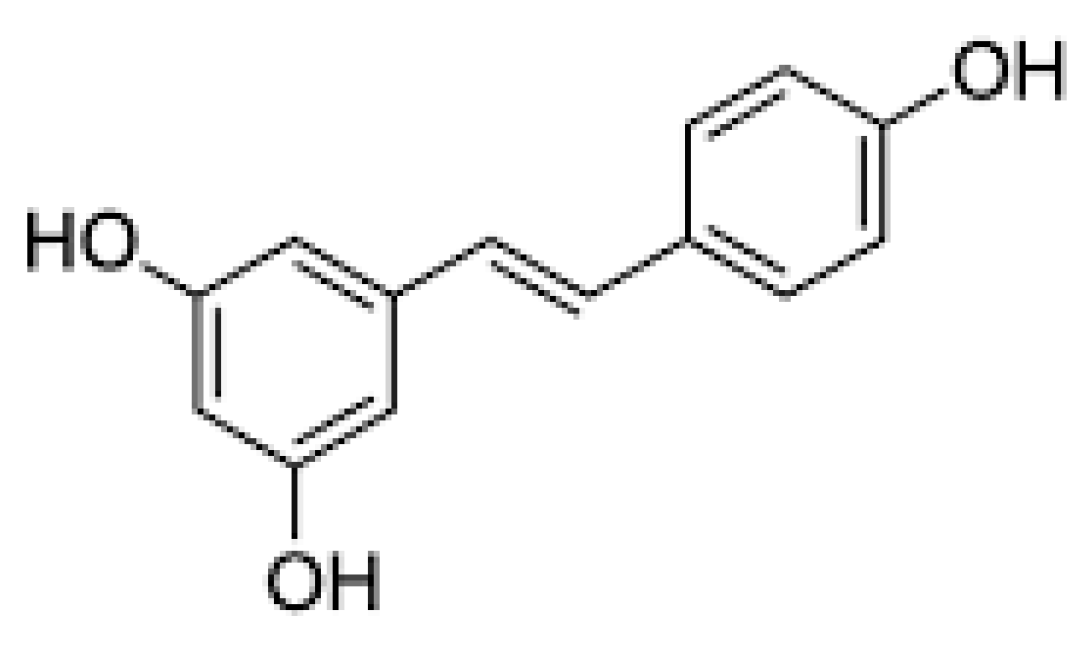
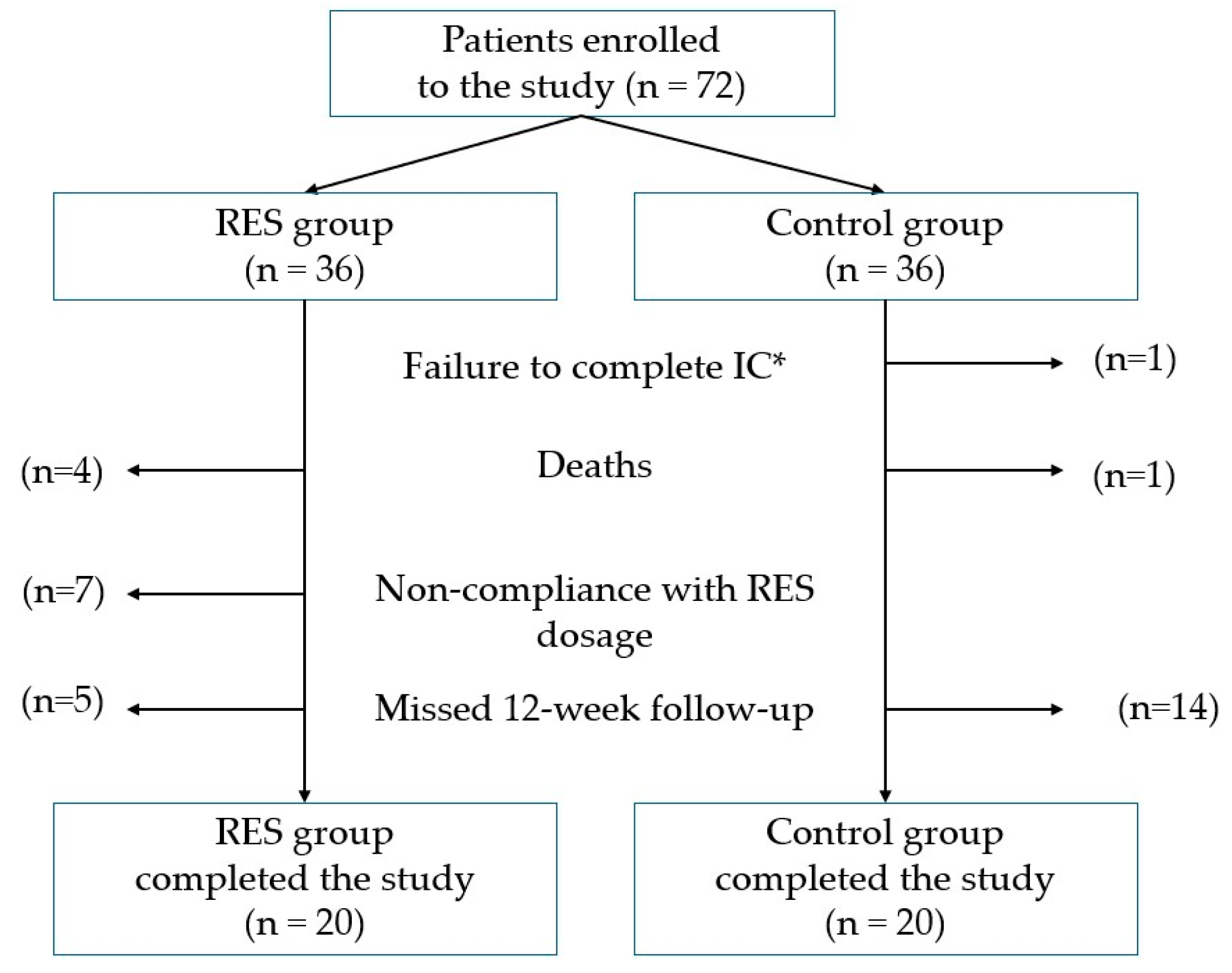
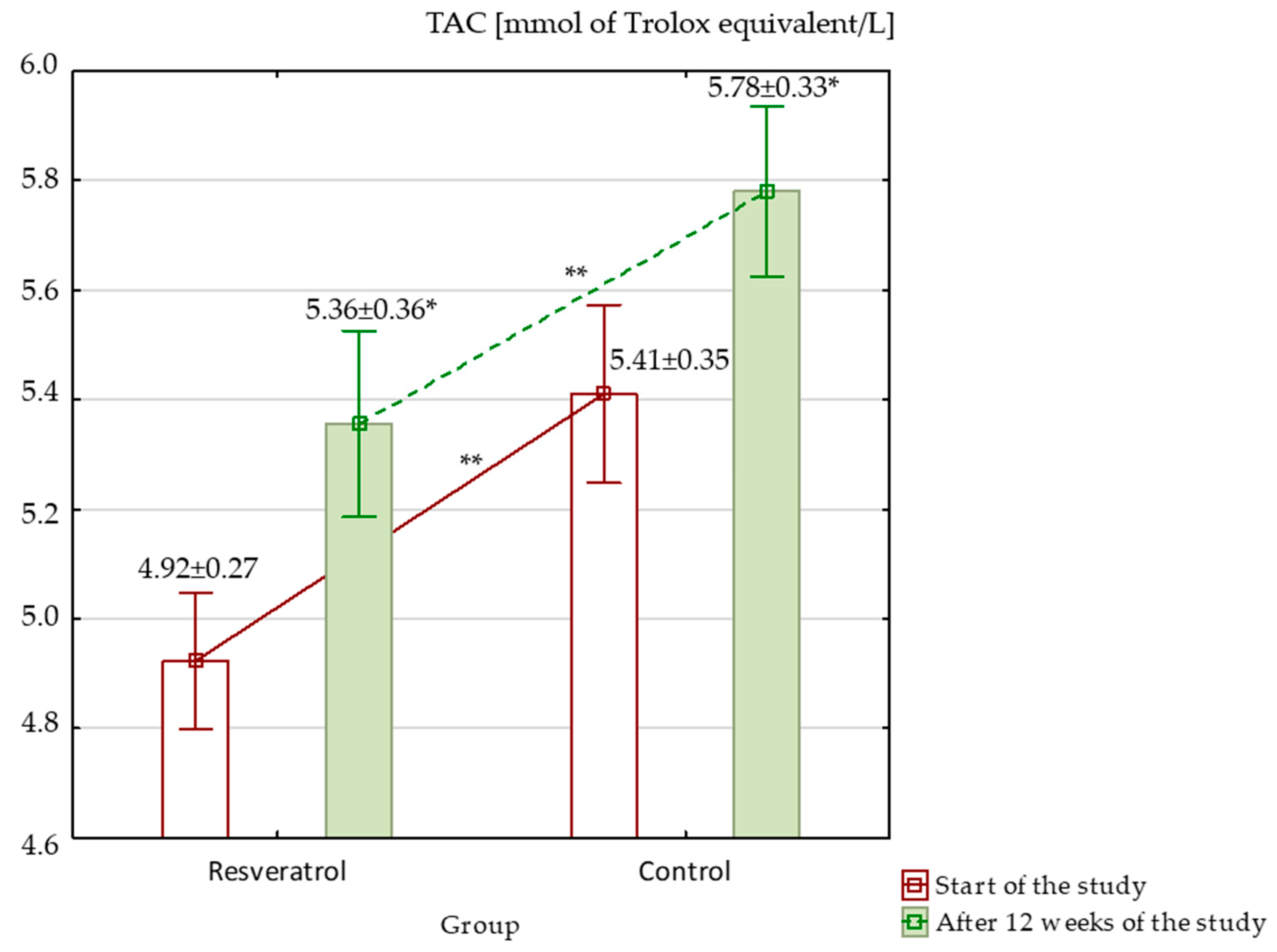
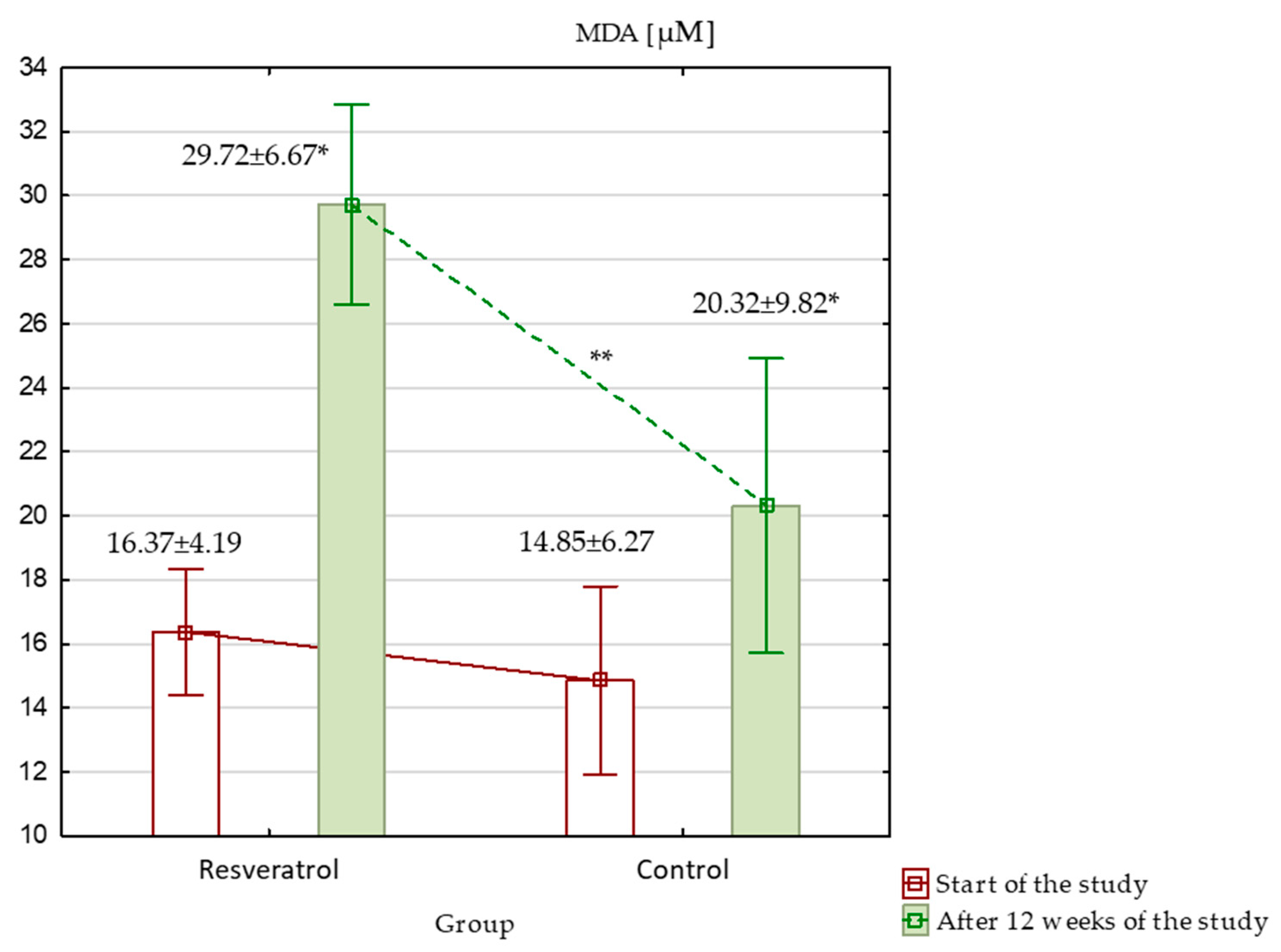
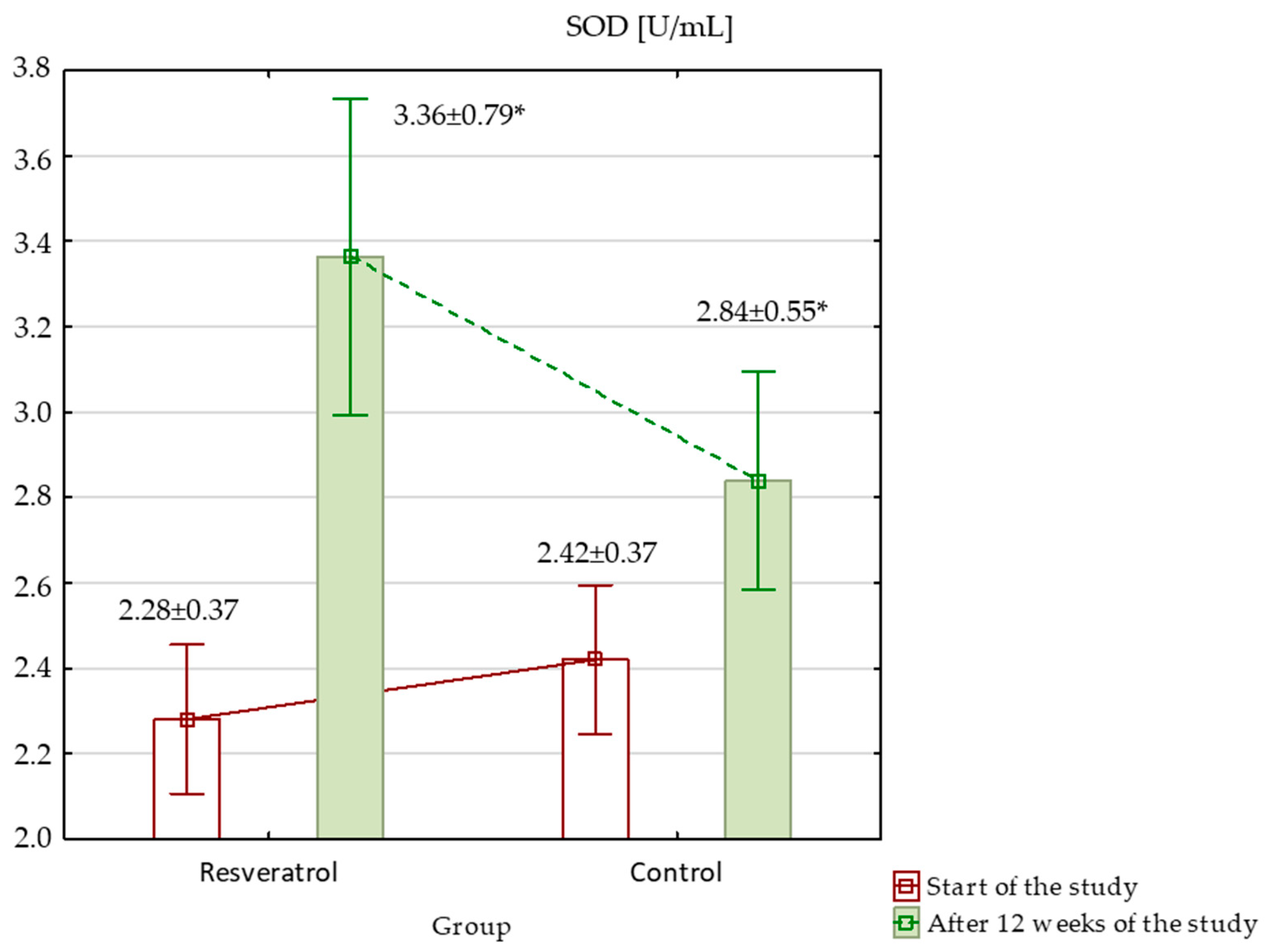
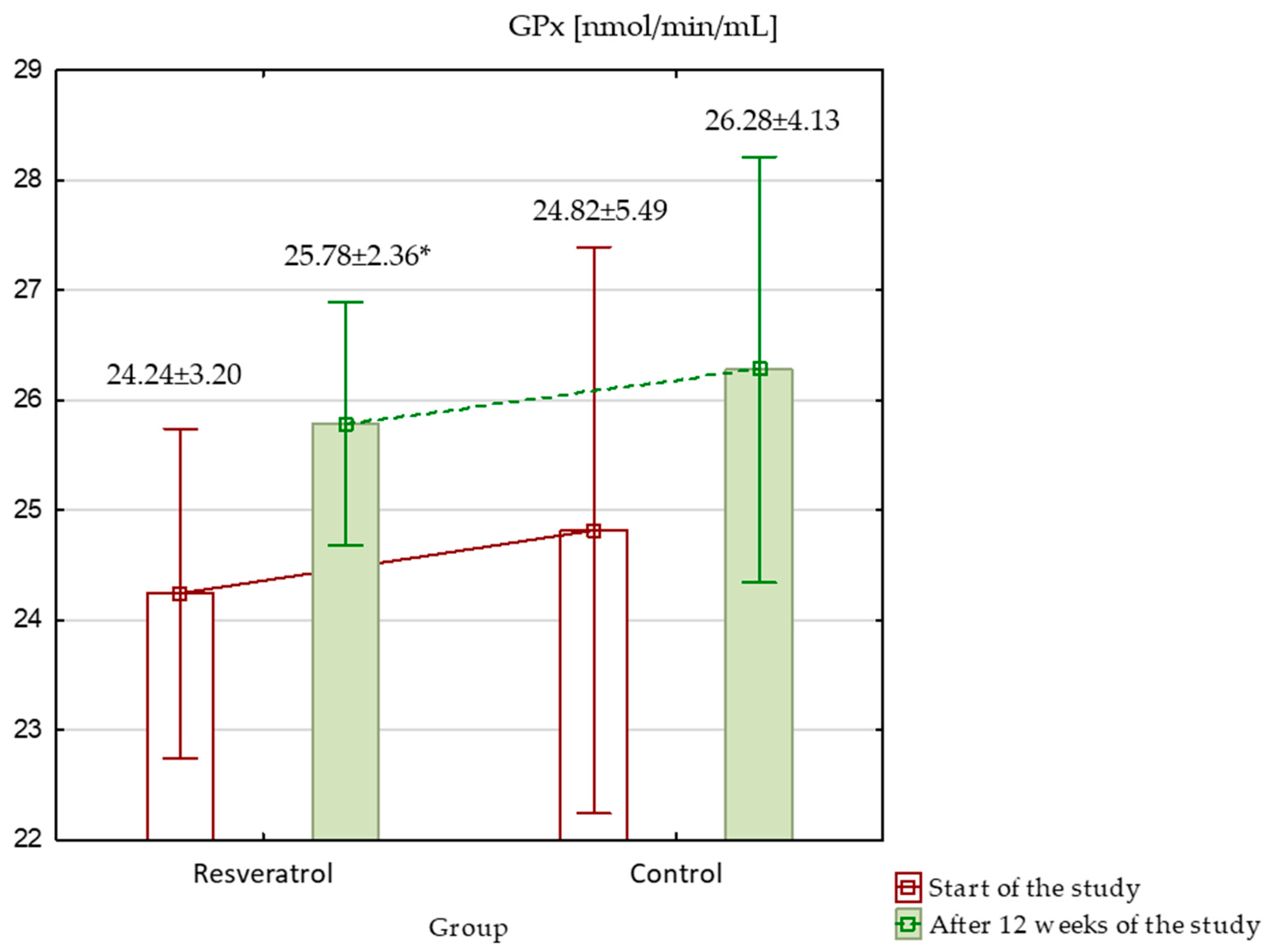
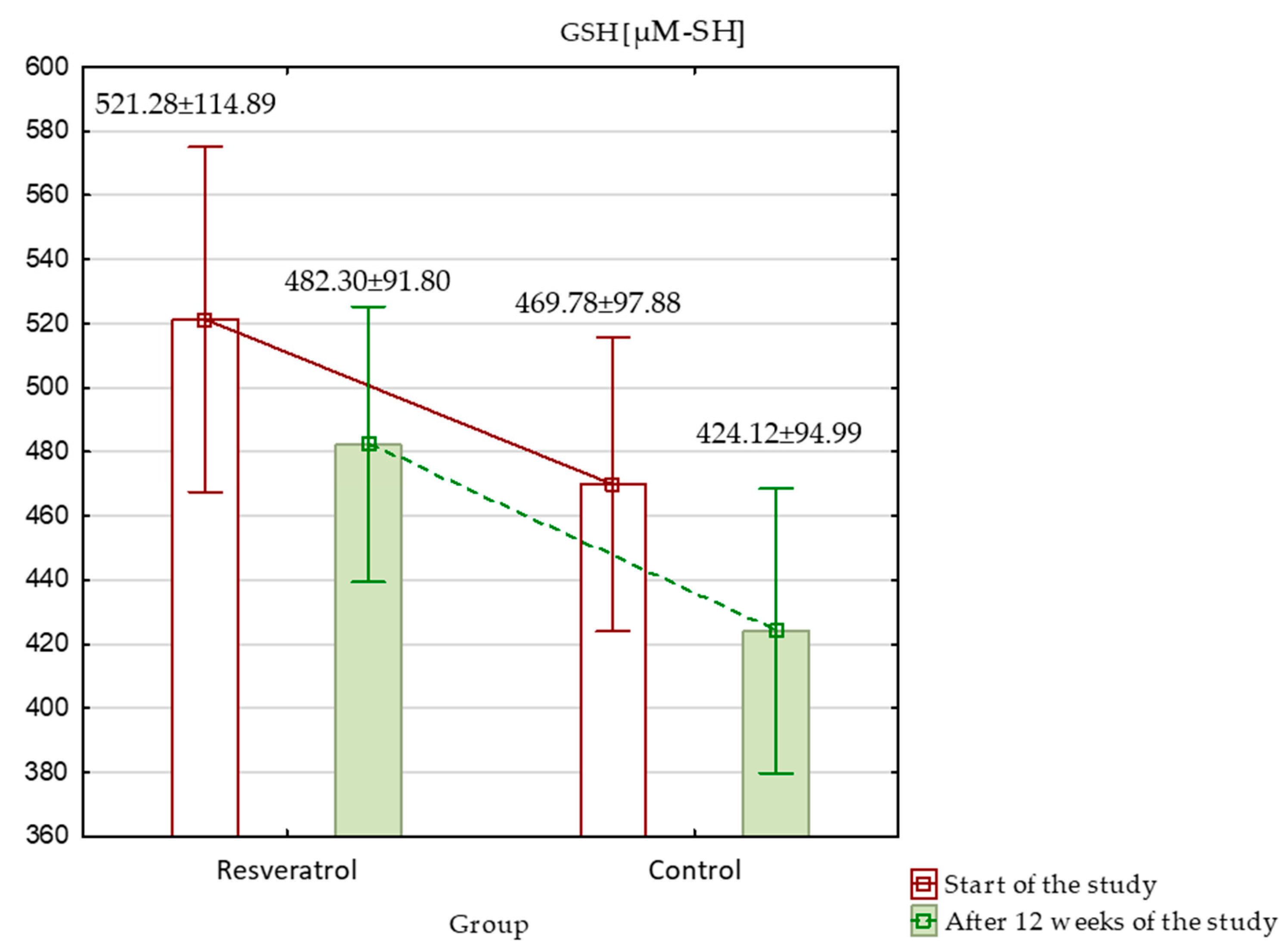
| Variable | Total (n= 40) | RES Group (n = 20) | Control Group (n = 20) | t-Test or U Mann–Whitney Test * | |||||||
|---|---|---|---|---|---|---|---|---|---|---|---|
| n | % | Mdn (IQR)/M ± SD * | n | % | Mdn (IQR)/M ± SD * | n | % | Mdn (IQR)/M ± SD * | |||
| Sex | Female | 13 | 32.5 | - | 6 | 30.0 | - | 7 | 35.0 | - | - |
| Male | 27 | 67.5 | 14 | 70.0 | 13 | 65.0 | |||||
| Age [years] | 30–50 | 5 | 12.5 | 65.65 ± 11.66 | 2 | 10.0 | 66.95 ± 10.36 | 3 | 15.0 | 64.35 ± 12.97 | p = 0.49 |
| 51–70 | 19 | 47.5 | 11 | 55.0 | 8 | 40.0 | |||||
| 71–90 | 16 | 40.0 | 7 | 35.0 | 9 | 45.0 | |||||
| Site of primary tumor | Tongue | 11 | 27.5 | - | 4 | 20.0 | - | 7 | 35.0 | - | - |
| Throat | 8 | 20.0 | 5 | 25.0 | 3 | 15.0 | |||||
| Tonsil | 7 | 17.5 | 3 | 15.0 | 4 | 20.0 | |||||
| Larynx | 5 | 12.5 | 3 | 15.0 | 2 | 10.0 | |||||
| Oral cavity | 5 | 12.5 | 4 | 20.0 | 1 | 5.0 | |||||
| Other | 4 | 10.0 | 1 | 5.0 | 3 | 15.0 | |||||
| Cancer stage | I | 1 | 2.5 | - | 0 | 0.0 | - | 1 | 5.0 | - | - |
| II | 14 | 35.0 | 7 | 35.0 | 7 | 35.0 | |||||
| III | 17 | 42.5 | 9 | 45.0 | 8 | 40.0 | |||||
| IV | 8 | 20.0 | 4 | 20.0 | 4 | 20.0 | |||||
| Mode of treatment | Surgery (S) | 4 | 10.0 | - | 1 | 5.0 | - | 3 | 15.0 | - | - |
| Chemotherapy (Ch) | 2 | 5.0 | 0 | 0.0 | 2 | 10.0 | |||||
| Radiotherapy (R) | 4 | 10.0 | 3 | 15.0 | 1 | 5.0 | |||||
| Chemoradiotherapy (ChR) | 7 | 17.5 | 5 | 25.0 | 2 | 10.0 | |||||
| S + R | 8 | 20.0 | 4 | 20.0 | 4 | 20.0 | |||||
| S + ChR | 7 | 17.5 | 4 | 20.0 | 3 | 15.0 | |||||
| Ch + R | 2 | 5.0 | 0 | 0.0 | 2 | 10.0 | |||||
| Ch + ChR | 4 | 10.0 | 3 | 15.0 | 1 | 5.0 | |||||
| More than 2 methods | 2 | 5.0 | 0 | 0.0 | 2 | 10.0 | |||||
| Duration of disease [days] | Less than 3 months | 1 | 2.5 | 272.5 (155.5–668.0) | 0 | 0.0 | 416 (220.0–1153.0) | 1 | 5.0 | 199.5 (126.0–326.5) | p = 0.006 |
| 3–6 months | 12 | 30.0 | 5 | 25.0 | 7 | 35.0 | |||||
| 7–12 months | 11 | 27.5 | 4 | 20.0 | 7 | 35.0 | |||||
| 13–24 months | 7 | 17.5 | 4 | 20.0 | 3 | 15.0 | |||||
| More than 24 months | 9 | 22.5 | 7 | 35.0 | 2 | 10.0 | |||||
| Duration of HEN [days] | Less than 3 months | 11 | 27.5 | 157 (80.5–417.0) | 2 | 10.0 | 339.0 (132.5–1067.5) | 9 | 45.0 | 92.0 (49.5–161.5) | p < 0.001 |
| 3–6 months | 12 | 30.0 | 5 | 25.0 | 7 | 35.0 | |||||
| 7–12 months | 6 | 15.0 | 4 | 20.0 | 2 | 10.0 | |||||
| 13–24 months | 4 | 10.0 | 3 | 15.0 | 1 | 5.0 | |||||
| More than 24 months | 7 | 17.5 | 6 | 30.0 | 1 | 5.0 | |||||
| Start of the Study | After 12 Weeks of the Study | Significance of Changes Within the Groups over 12 Weeks *** | ||||||
|---|---|---|---|---|---|---|---|---|
| RES Group (n = 20) Mdn (IQR)/M ± SD * | Control Group (n = 20) Mdn (IQR)/M ± SD * | Significance of Differences Between the Groups ** | RES Group (n = 20) Mdn (IQR)/M ± SD * | Control Group (n = 20) Mdn (IQR)/M ± SD * | Significance of Differences Between the Groups ** | RES Group (n = 20) | Control Group (n = 20) | |
| Body weight [kg] | 63.72 ± 11.30 | 63.21 ± 13.92 | p = 0.35 | 64.40 ± 11.54 | 65.56 ± 15.20 | p = 0.79 | p = 0.35 | p = 0.003 |
| BMI [kg/m2] | 22.93 ± 2.79 | 22.50 ± 3.34 | p = 0.66 | 23.17 ± 2.92 | 23.28 ± 3.57 | p = 0.92 | p = 0.35 | p = 0.004 |
| REE [kcal/day] | 1461 ± 336 | 1502 ± 481 | p = 0.76 | 1581 ± 309 | 1686 ± 582 | p = 0.48 | p = 0.02 | p = 0.03 |
| FFM [kg] | 45.68 ± 8.80 | 47.20 ± 13.03 | p = 0.67 | 46.10 ± 8.30 | 47.31 ± 13.46 | p = 0.73 | p = 0.41 | p = 0.87 |
| FM [kg] | 18.04 ± 4.89 | 16.02 ± 5.01 | p = 0.20 | 18.30 ± 5.46 | 18.26 ± 5.43 | p = 0.98 | p = 0.69 | p = 0.001 |
| PhA [°] | 5.12 ± 0.73 | 5.13 ± 0.88 | p = 0.98 | 5.77 ± 0.89 | 5.39 ± 0.89 | p = 0.18 | p = 0.004 | p = 0.11 |
| CRP [mg/L] | 2.50 (1.00–7.85) | 3.15 (1.00–26.65) | p = 0.29 | 3.95 (1.65–12.10) | 4.10 (1.15–17.65) | p = 0.89 | p = 0.09 | p = 0.42 |
| Total protein [g/dL] | 7.24 ± 0.36 | 7.28 ± 0.55 | p = 0.79 | 7.12 ± 0.27 | 7.44 ± 0.53 | p = 0.02 | p = 0.13 | p = 0.29 |
| Albumin [g/dL] | 4.55 (4.35–4.70) | 4.50 (4.35–4.70) | p = 0.88 | 4.55 (4.40–4.80) | 4.50 (4.40–4.70) | p = 0.46 | p = 0.67 | p = 0.70 |
Disclaimer/Publisher’s Note: The statements, opinions and data contained in all publications are solely those of the individual author(s) and contributor(s) and not of MDPI and/or the editor(s). MDPI and/or the editor(s) disclaim responsibility for any injury to people or property resulting from any ideas, methods, instructions or products referred to in the content. |
© 2025 by the authors. Licensee MDPI, Basel, Switzerland. This article is an open access article distributed under the terms and conditions of the Creative Commons Attribution (CC BY) license (https://creativecommons.org/licenses/by/4.0/).
Share and Cite
Ławiński, M.; Zadka, K.; Ksepka, N.; Matin, M.; Wysocki, K.; Karkocha, D.; Gradowska, A.; Atanasov, A.G.; Słodkowski, M.; Wierzbicka, A.; et al. Does Resveratrol Impact Oxidative Stress Markers in Patients with Head and Neck Cancer Receiving Home Enteral Nutrition? Nutrients 2025, 17, 504. https://doi.org/10.3390/nu17030504
Ławiński M, Zadka K, Ksepka N, Matin M, Wysocki K, Karkocha D, Gradowska A, Atanasov AG, Słodkowski M, Wierzbicka A, et al. Does Resveratrol Impact Oxidative Stress Markers in Patients with Head and Neck Cancer Receiving Home Enteral Nutrition? Nutrients. 2025; 17(3):504. https://doi.org/10.3390/nu17030504
Chicago/Turabian StyleŁawiński, Michał, Katarzyna Zadka, Natalia Ksepka, Maima Matin, Kamil Wysocki, Dominika Karkocha, Aleksandra Gradowska, Atanas G. Atanasov, Maciej Słodkowski, Agnieszka Wierzbicka, and et al. 2025. "Does Resveratrol Impact Oxidative Stress Markers in Patients with Head and Neck Cancer Receiving Home Enteral Nutrition?" Nutrients 17, no. 3: 504. https://doi.org/10.3390/nu17030504
APA StyleŁawiński, M., Zadka, K., Ksepka, N., Matin, M., Wysocki, K., Karkocha, D., Gradowska, A., Atanasov, A. G., Słodkowski, M., Wierzbicka, A., & Jóźwik, A. (2025). Does Resveratrol Impact Oxidative Stress Markers in Patients with Head and Neck Cancer Receiving Home Enteral Nutrition? Nutrients, 17(3), 504. https://doi.org/10.3390/nu17030504







